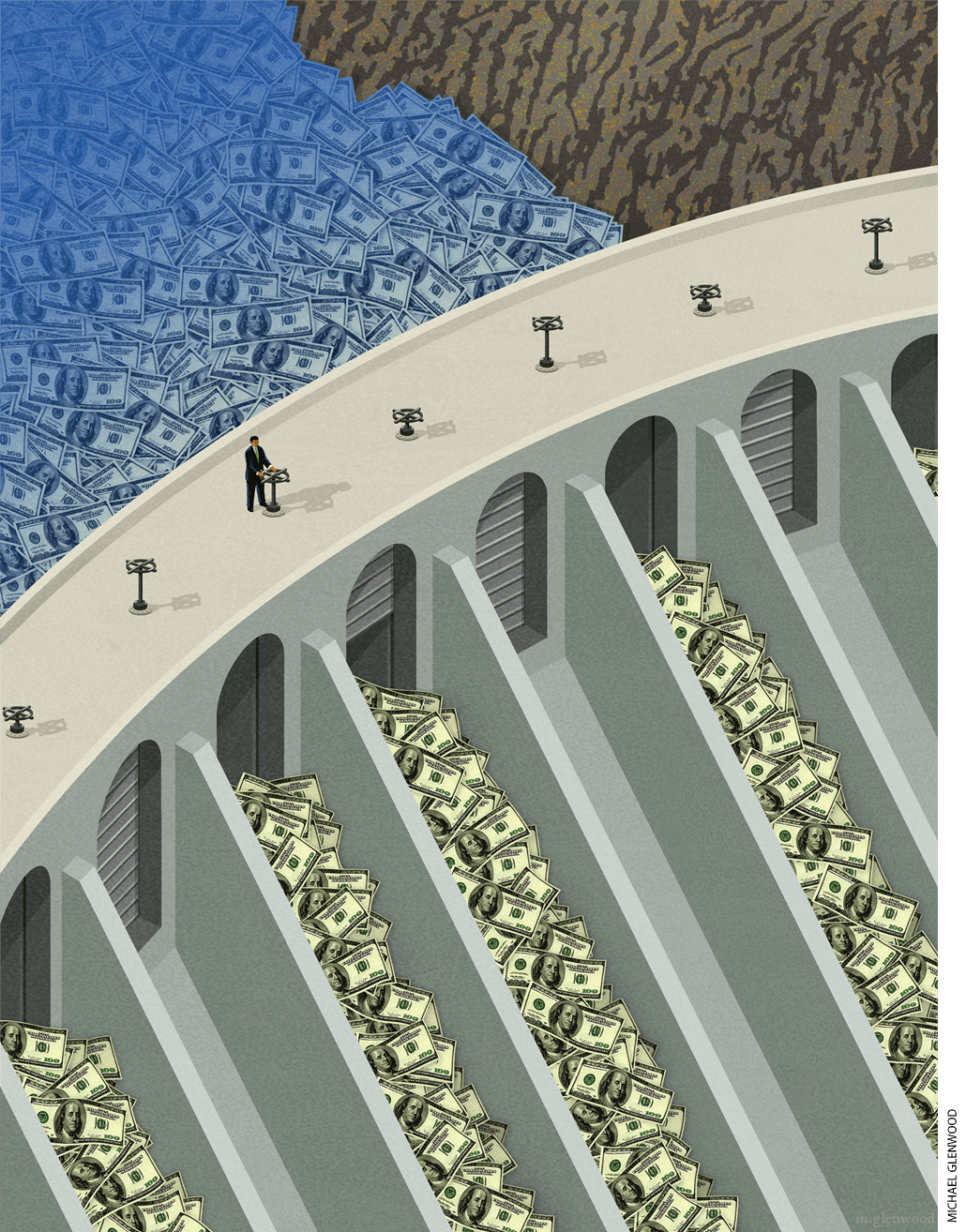
For decades, most school choice advocates promoted vouchers as a means-tested program for families that would not otherwise be able to afford private schools. Targeted vouchers were deemed equitable, politically prudent, and fiscally responsible. Since 2020, however, a new wave of advocacy has prioritized the creation of universal programs that serve nearly all families irrespective of their household income—and such initiatives have been adopted in 11 states to date. To what extent do universal programs compromise the moral, political, and fiscal appeal of vouchers as they were first conceived? Is the rapid expansion of universal programs across the country worth that compromise? Derrell Bradford, president of the advocacy organization 50CAN, argues that it is. Michael Petrilli, president of the Thomas B. Fordham Institute and an executive editor of Education Next, advocates for choice expansion that continues to prioritize need.
We Need to Welcome the Wealthy under the Tent of Private–School Choice
By Derrell Bradford
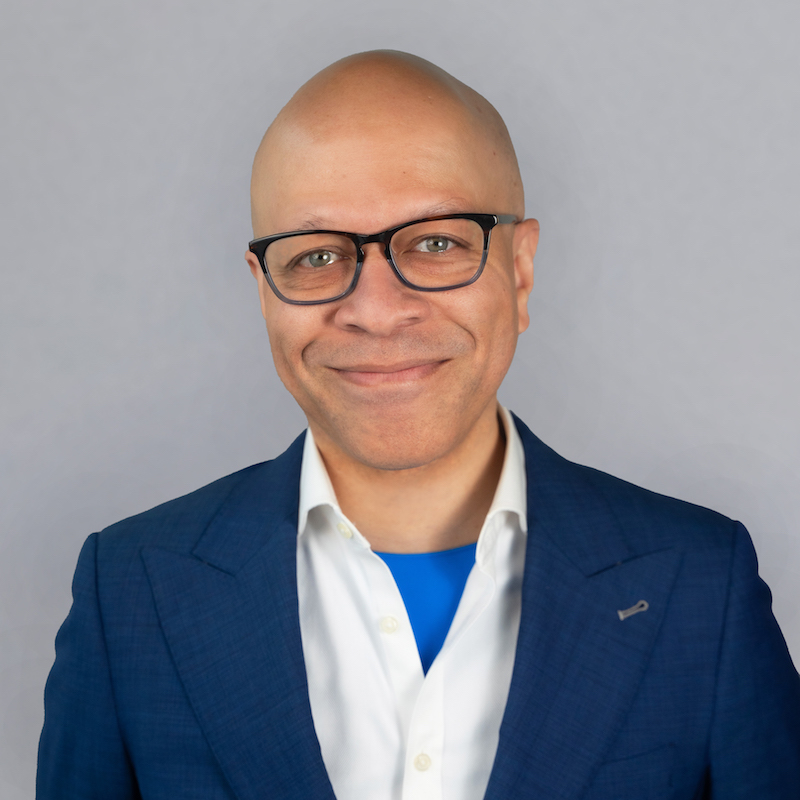
There are no graduates of the Princeton International Academy Charter School, a Mandarin immersion school that was the brainchild of a rocket scientist, because it was never allowed to open. And though the proposed school educated no students, I learned a great deal while advocating for it. Above all, I learned about “the rich,” their political influence, and their power to defeat an attempt to expand educational opportunities for children from low-income families—children attending some of the nation’s lowest-performing but costliest-per-pupil public schools.
It was 2010, and the founder and board members of PIACS, as its supporters knew it, had made the mistake of choosing the town of West Windsor, New Jersey, for its home, drawing the ire of well-heeled opponents there, from the similarly affluent town of Princeton, and from other neighboring communities. Irony loomed over all of this. Princeton was, and still is, home to the Princeton Charter School (one of the state’s oldest and best), and one of the leaders of the movement against PIACS was a college professor whose child attended Princeton Charter. For me, charter schools had always been about expanding choice and opportunity for kids zoned to underperforming schools, but they’d also been about the ability to develop “different” kinds of public schools. Not every school, even a good one, works for every kid. For these reasons I thought we should fight to help PIACS open, but that was far from the consensus opinion in the area. Later that year, New Jersey Governor Chris Christie’s administration (perhaps rightly) decided to prioritize the authorizing of charter schools in Newark, Camden, and other urban centers over those in places that would serve urban-fringe or suburban families. This practice of not approving what the administration called “boutique charters” has, by all accounts, worked for students in cities, and that is laudable.
The administration’s shift in approach did not, however, mollify the wealthy suburban opposition to charter school expansion (which later metastasized into the state’s Save Our Schools chapter). A bill was soon introduced in the New Jersey Legislature that would have required approval from the local school board to open a new charter school in the state. This would have amounted to a de facto moratorium on charter growth statewide, and the bill passed the state’s general assembly, though it was headed off in the senate. I was dumbstruck.
There were many lessons to learn from this experience, and it took me years to process them. The most important, though, was that our diverse coalition—comprising families and business leaders, religious and ethnic groups—was not diverse enough. And by that I mean it was not wealthy enough to help us achieve and sustain the sort of change we sought. While the anti-choice folks had not organized with the urgency or the moral conviction we had, they had amassed the money and therefore the influence to be heard and to sway policymaking. It was this realization and the raw politics of it that made me an advocate of universal school-choice programs, that is, those that include families of all income levels. The evidence was too compelling, and the need is too great, not to take this position. If the rich are not in your coalition, you have a weak coalition. If they don’t benefit from your policy, you have a policy that will be difficult to maintain. It is just that simple.
Misconceptions about Universal Choice
This issue is important as, to the chagrin of some, more states embrace universal school-choice initiatives. Indeed, some choice supporters, newly turned fiscally hawkish, object to using public money to pay the tuition of children already attending private schools, whose parents can presumably afford to pay it themselves. This objection is misconstrued. First, not all children currently attending private schools come from wealthy families; private schools exist at a variety of price points. Early in my career, many of the strongest advocates for targeted private-school vouchers were paycheck-to-paycheck parents whose children were already enrolled in urban private schools. These parents understood that making it possible for more students to attend would improve the health of the school overall, but they themselves would have benefited from the program, too. And that would be a good thing. Supporting working-class parents who are paying through the nose to keep their children in private school is a worthy goal. This says nothing of the fact that charter schools, among the most widespread of choice programs, are not means tested at all.
Fiscal hawks also express concerns about the consequences of universal choice programs for state budgets. But, as just noted, the cost of allowing a child to stay in a school that works for them with state support is worth incurring. And contrary to popular belief, several universal education savings account programs, though available to all families, prioritize low-income families in the distribution of funds. More pointedly, some ESA programs were passed alongside massive increases in traditional public-school spending devoted largely to raises in teacher salaries. These budget increases benefit all students, including wealthy ones, who attend public schools. Are skeptics who are concerned about state budgets prepared to roll back this subsidy for the rich as well?
There is a sad cynicism that underpins the budget concerns we have historically heard from enemies of expanding choice—but now hear from its ostensible allies as well. It is an article of faith among choice critics that traditional public schools never have enough money, while any alternatives (charters, ESAs, and the like) cost too much. Instead of making students who choose alternatives second-class citizens of school finance, choice advocates should support school funding arrangements in which all the dollars, not just some of the dollars, follow the child. It’s also worth noting that a fiscal view that assumes all students will go to private schools or homeschool when those options are affordable is one that shows the least faith in the ability of the public schools to retain or attract students in a choice environment.
A Noxious Covenant
Still, there are those who will never be convinced that including the wealthy is a good idea (despite recent trends in related policy choices, such as making free school lunch universal) and others who see universal private-school choice as harmful to equity. The former individuals notwithstanding, the latter are mistaken, and we need look only to the public schools themselves to understand why.
The public schools have the rich in their coalition, and they pay handsomely for them with a noxious policy concoction that secures their backing. The proposition works like this: “Support us and we will give you a publicly subsidized school, but it won’t be open to the public at large. It will, instead, only be available to you and your neighbors or a small group of students who can afford to pay tuition to attend, if we allow them to enroll. We will draw an attendance boundary around the school to ensure its exclusivity, and we will fine, arrest, or prosecute anyone who violates that boundary by lying about their address or through other trickery. You will also get to thump your chest and describe yourself as a ‘public school parent,’ which may be of great use to you in certain social circles. Finally, in the greatest subsidy available, your housing value will appreciate as a function of this exclusivity. In return, you’ll oppose schools or methods of school finance that would break the link between you, the house, the school, the boundary, and us.”
While it may seem flip to describe “the proposition” in this manner, we sadly know the covenant is as real as its effects are deleterious to the expansion of educational opportunity. Charter schools and, of course, education savings accounts, vouchers, and the like often circumvent the lines that hold this coalition of the rich together with their exclusive public schools. While some residents of affluent districts may still opt for private school, the relationship between housing value and school exclusivity remains a crucial factor in retaining their support.
The well-off are a powerful constituency, and the public school apparatus has offered them an educational and financial package so lucrative that few people could (or do) say no, whether they reside in red states or blue. Thus, in building a “diverse” constituency to ballast themselves politically, the public schools have appealed not in a targeted way to the needy, but broadly and most beneficially to those who need very little. And, to date, this strategy of subsidizing the rich has worked brilliantly for the system.
Incentives work, and it’s unrealistic to expect people to act against them. It’s also naive to ignore what is at work here as we think about what it will take to create and grow charter schools and other choice programs for low-income students in America. For all their excellence in the Northeast, charter schools there are growing slowly (if at all) despite high demand, not because low-income kids of color attend them but because that’s who predominantly attends them. Contrast this to the state of Arizona, where more than 200,000 students from families poor and rich attend charter schools, and where models range from classical to gap-busting, ensuring that they draw support in all places and from a wide variety of people. Arizona’s exemplar is powerful and doubly ironic, as it was, for many years, the bête noire of charter purists on account of its open authorizing approach. Now it also features a wildly popular universal education savings account program. We have, indeed, come full circle.
Although my work focuses primarily on improving educational opportunity for those of lesser means, I begrudge no family, of any income, their ambition or their desire to obtain the best possible education for their children. In the end, I am a pragmatist, and that is why I support universal forms of school choice. For me, the “how” of including the rich in these programs (for example, possibly implementing a sliding scale or giving priority to certain groups) is a discussion worth having, but the “whether” is not. If we want choice programs of all types to grow so we can expand opportunity for the needy, the wealthy must have access to them too, or else they will oppose them—and their voices are loud. Politics is about addition, and I would urge advocates who may be on the fence about the issue to consider that before opposing a larger and more economically diverse coalition for choice that could make it permanent for all families.
School Choice Need Not Mean a Costly Windfall for the Rich
By Michael J. Petrilli
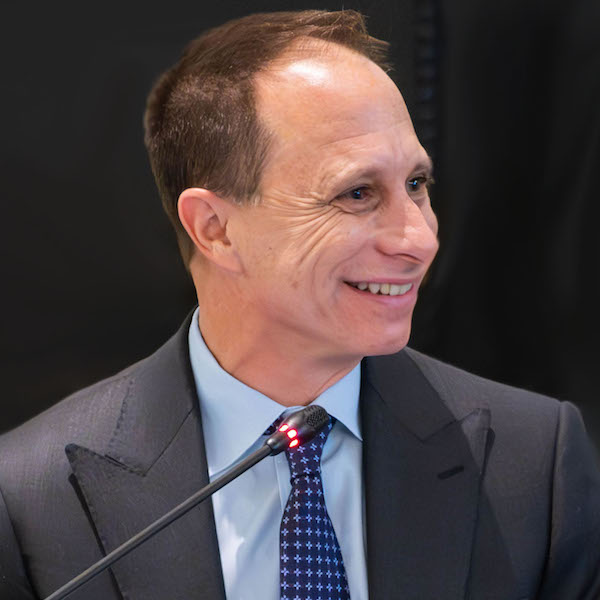
Americans take consumer choice for granted in practically every aspect of society except K–12 education—so the spread of “educational freedom,” as many school choice advocates now call it, is a welcome development. It’s long past time for schools to be subject to the same competitive forces as other goods and services. And in our huge, diverse society, it makes sense to embrace a pluralistic school system that allows all families to find educational institutions that match their values, hopes, and goals for their children.
Under the surface of these victories, however, an important debate is brewing about how to balance the drive for educational freedom with other essential values, including fairness and fiscal responsibility. Must the expansion of school choice result in windfalls for America’s wealthiest families, particularly those that already send their children to private schools? Especially when that means blowing big holes in state budgets?
Back when a coalition of conservatives and Black liberals successfully pressed for America’s first school-voucher program in Milwaukee in the early 1990s, their focus was on giving low-income students of color a leg up. Their argument was clear and morally compelling: we needed to level the field by allowing disadvantaged kids trapped in the then-atrocious Milwaukee Public Schools to access the city’s high-quality private schools, including Catholic and Lutheran ones. After all, as school choice pioneer (and former Milwaukee superintendent) Howard Fuller often said, rich families already had school choice—it was time that poor families did, too. Similar (and similarly successful) arguments were made in Cleveland and Washington, D.C.
As the school choice movement matured, advocates pushed for ever-larger swaths of families to qualify for private-school vouchers courtesy of taxpayers. It wasn’t hard to argue that working-class families should have these options, given that the tuition in most private schools, including some parochial ones, was out of reach for them, too. But now some advocates, including my friend and sparring partner here, Derrell Bradford, make the case that expanding eligibility to more and more families, regardless of their income, will help build long-lasting support for school choice. It’s no secret that affluent families have more political juice than poor folks. Many school choice supporters have even adopted the adage, long embraced by progressive Democrats, that “a program for the poor is a poor program.”
Yet the drive for universal school-choice programs—those without means-testing—presents a fiscal challenge while also triggering a different sort of fairness dilemma. When choice programs allow students to move from public to private schools, they generally save taxpayers money because the publicly funded scholarships cost the public fisc less (per pupil) than district-operated schools do. But when the government starts to subsidize students already enrolled in private schools, it incurs a brand-new public expense. Those kids weren’t already attending school with taxpayer assistance. And with about 9 percent of students attending private schools—and those children coming disproportionately from wealthy families—adding them to the public rolls can add up fast. Maybe bringing these families into the school choice coalition has some political benefit—but surely it also exacts a political cost as taxpayers watch millions of dollars flow to prosperous elites who don’t need the money.
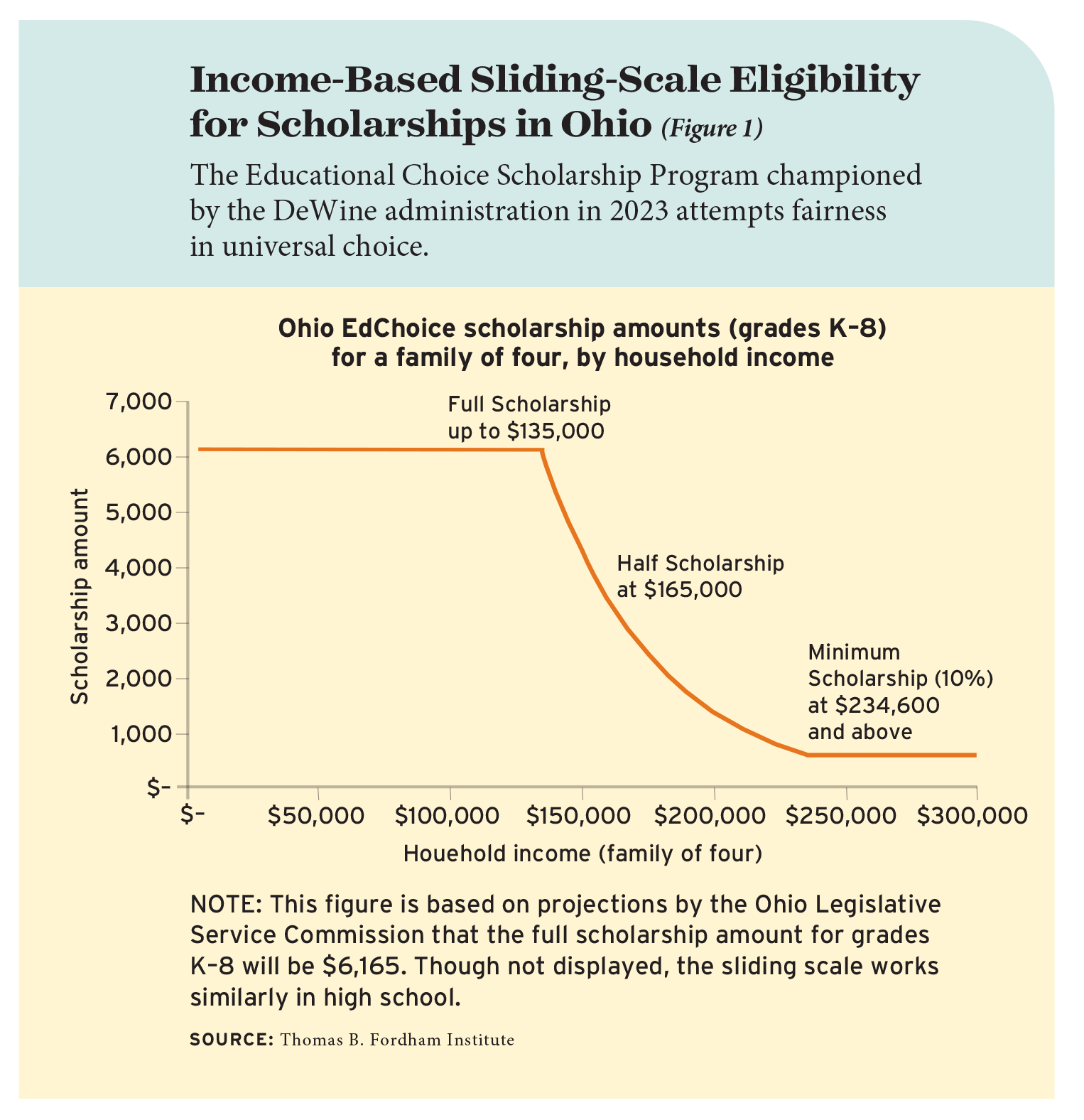
Universal but Fair
Now for the good news: a handful of states have found a way to champion both educational freedom and fiscal conservatism. In Ohio, Governor Mike DeWine and his Republican legislative allies dramatically expanded school choice in the Buckeye State in the summer of 2023, making all families eligible for vouchers through the state’s Educational Choice Scholarship Program—that is, instituting universal private-school choice. However, they also adopted a sliding scale to link voucher amounts to family incomes (see Figure 1). Those making up to about $135,000 for a family of four receive the full amounts (between about $6,000 and $8,500 per student, depending on grade level). Above that level, vouchers are gradually reduced, up to incomes of around $235,000. Families earning more than that may still receive the scholarships, but they are much smaller—about $600 for an elementary school student.
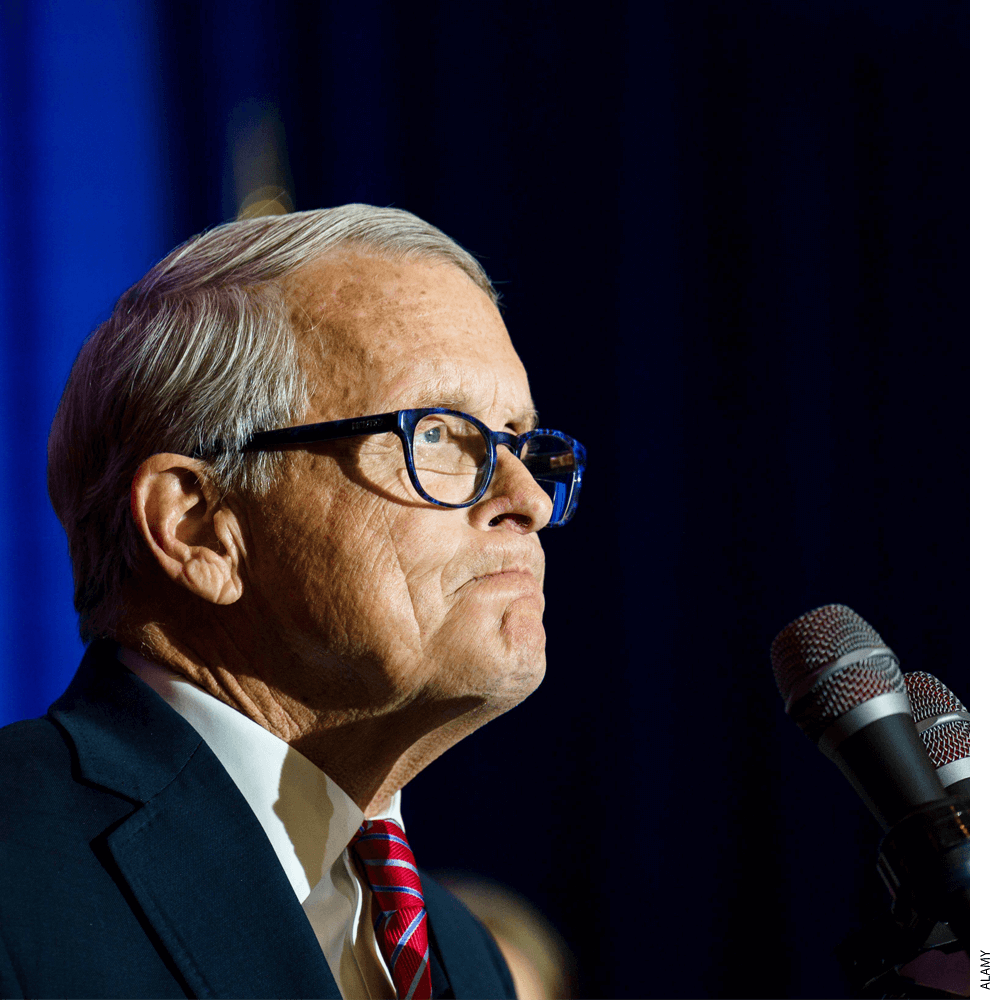
By sharply reducing scholarship amounts for the most affluent families, Ohio policymakers saved taxpayers a ton (which also helped to keep taxes in check). That’s because the richest families in Ohio, as elsewhere, are the ones most likely to already have their kids in private schools, paying tuition out of their own pockets. Adding all of those students at full freight to the burden on the state treasury would be a sizable expense.
The program cost the Buckeye State $440 million in its first year. My colleague Aaron Churchill has calculated that, by instituting a sliding scale and limiting the wealthiest families to partial scholarships (rather than providing full scholarships to everyone), Ohio lawmakers avoided spending an additional $300 million. In other words, a universal school-choice program without a sliding scale would have cost the state about 68 percent more.
Oklahoma also uses a sliding scale for its private-school choice program, and a newly enacted initiative in Louisiana will do the same. Other states might well follow suit rather than heeding Arizona’s example, which hands out $8,000 per child regardless of family income, meaning that millionaires with multiple children in private school will receive a six-figure windfall over the course of their kids’ K–12 careers.
EdNext in your inbox
Sign up for the EdNext Weekly newsletter, and stay up to date with the Daily Digest, delivered straight to your inbox.
Progressive Funding
Now, to be sure, were those millionaires to send their kids to public schools, they would also enjoy a significant public subsidy. But here’s the difference: in most parts of America, the vast majority of support for affluent kids’ public education comes from local property taxes, meaning from rich people taxing themselves and their neighbors. Very little comes from state coffers, because of the progressivity of our funding systems (that is, states provide less money per pupil to wealthy districts than to poorer ones). There are exceptions, of course, such as wealthy families who choose to live in relatively low-wealth districts. But in general, state governments don’t spend much on educating the richest children. So it should be with school choice programs.
Indeed, policymakers could even tie the sliding scale for school choice programs to the progressivity of its public-school funding formula. If the state provides, say, $3,000 per pupil to wealthy districts, but $13,000 per pupil to the poorest ones, it could offer vouchers worth $3,000 to families living in the wealthiest districts, and vouchers worth $13,000 to families living in the poorest ones. Then both the public and private school sectors would operate under the same principle: states should contribute very little to educate the wealthiest children, given that local property taxes (for public schools) or tuition from parents (for private schools) can easily make up the difference. (Charter schools are a different story, given that in most states they lack access to both local taxes and tuition.)
By all means, reformers, keep fighting for school choice. But don’t give up on fiscal responsibility and basic fairness while you do it.
Michael J. Petrilli is president of the Thomas B. Fordham Institute, visiting fellow at Stanford University’s Hoover Institution, and an executive editor of Education Next.
This article appeared in the Fall 2024 issue of Education Next. Suggested citation format:
Bradford, D., and Petrilli, M.J. (2024). Should the Wealthy Benefit from Private-School Choice Programs? Education Next, 24(4), 66-71.


